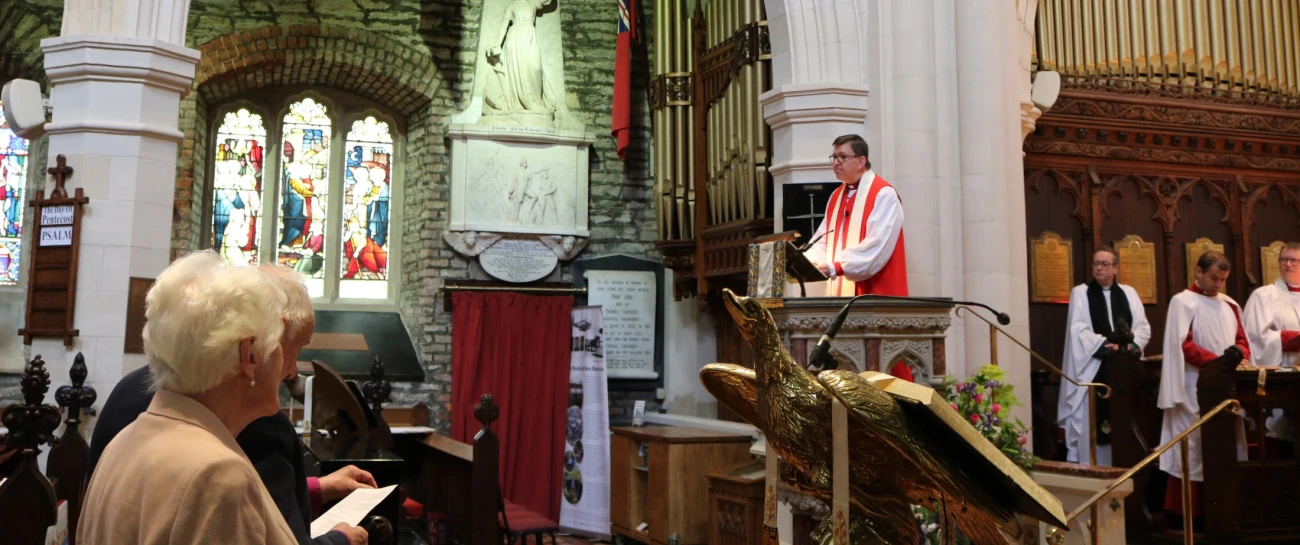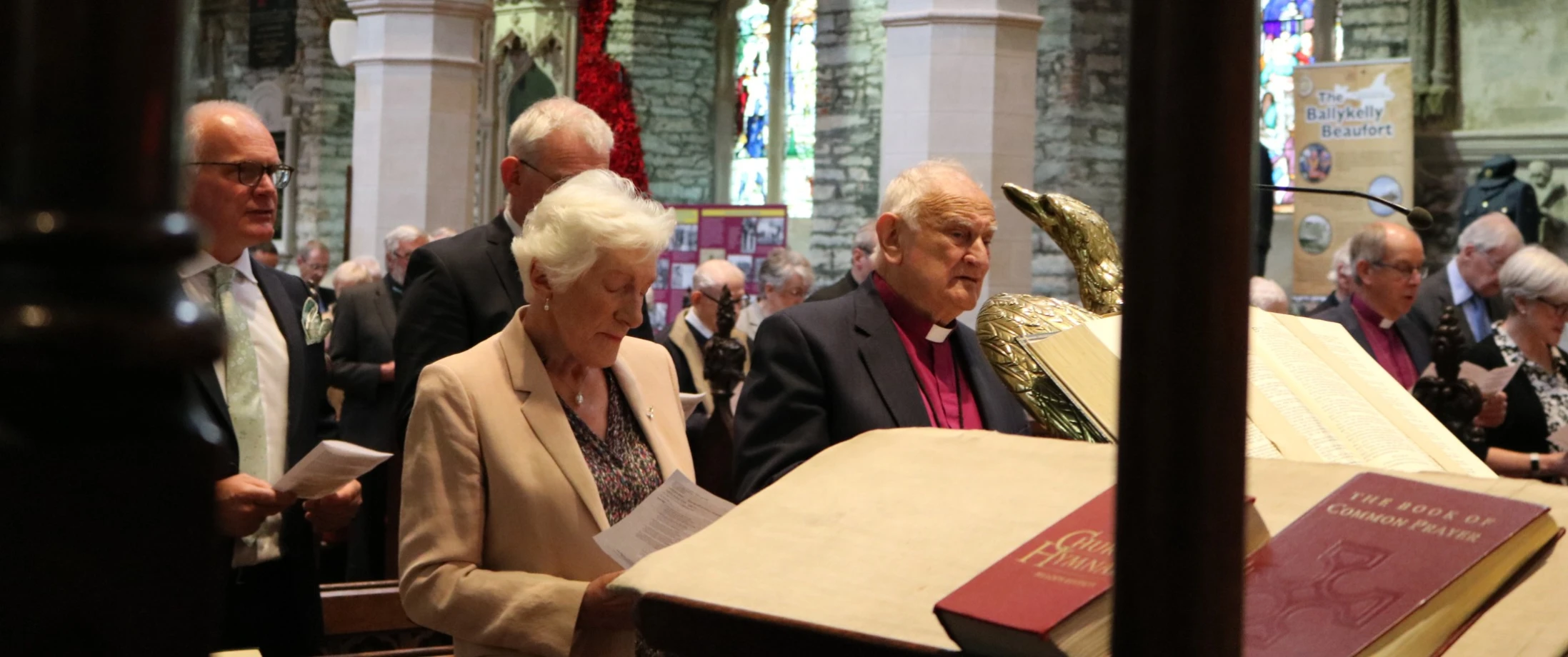Lord Eames celebrates 50 years of service as bishop
Half a century of service in episcopal ministry was celebrated this morning (St Columba’s Day) when a congregation gathered for a Choral Eucharist in St Columb’s Cathedral, Londonderry, to mark the fiftieth anniversary of the consecration of Bishop Robin Eames.
Lord Eames served as Bishop of Derry and Raphoe from 1975 to 1980, and thereafter Bishop of Down and Dromore, and Archbishop of Armagh and Primate of All Ireland from 1986 until his retirement in 2006. He was consecrated in St Patrick’s Cathedral, Armagh, on 9th June 1975, by Archbishop George Otto Simms, at 38 years of age.
The service was led by Archbishop John McDowell and the preacher was Bishop Andrew Forster, the current Bishop of Derry and Raphoe. Bishop George Davison (Bishop of Connor), Bishop Ian Ellis (Bishop of Clogher) and Bishop Patrick Rooke (formerly Bishop of Tuam, Killala and Achonry) were also present, and Archdeacon Mark Harvey (Archdeacon of Dromore) represented Bishop David McClay (Bishop of Down and Dromore).
Scripture was read by Bishop Forster and Dean Shane Forster (Dean of Armagh) and intercessions led by Archdeacon Robert Miller (Archdeacon of Derry).
A reception was held afterwards in the Chapter Room, giving many representatives from parish life in the diocese, and guests who had travelled from elsewhere, the opportunity to congratulate Lord Eames, Lady Christine Eames and their sons Michael and Niall.
Bishop Andrew Forster’s sermon in full

(Readings: Romans 15: 1-6 & John 12: 20-26)
We gather in St Columb’s Cathedral this morning with deep thankfulness, full hearts, and in the profound joy and privilege of our shared faith in Jesus Christ. And we gather to mark today a remarkable anniversary – an anniversary that is almost unique in the Anglican Communion.
To put that in some sort of context, if the Diocese of Derry and Raphoe decides to do the same thing for me after 50 years of episcopal ministry, I would be 102.
Back on the feast day of St Columba, in 1975 in the Cathedral Church of St Patrick’s, Armagh, the Primate (the saintly George Otto Simms) consecrated a young man to be the bishop of this diocese. I know that for you Robin, for Christian, for Michael and for Niall, this diocese has always held a very special place in your heart. You always talk about it with such love and affection and warmth. I can fully understand that warmth and affection for Derry and Raphoe.
Three weeks before Robin was consecrated, the redoubtable Canon John Barry (Remember him? Cromlyn?) wrote this in his column in the Church of Ireland Gazette. I quote:
‘We have appointed a really young bishop and how often over the years have we pleaded for just that, asking that a man should be elevated on account of what he might do in the future, rather than a sort of reward for what he has done in the past. An era of great promise has opened up for the Diocese of Derry and Raphoe and indeed for the Church of Ireland as a whole.’
Those words, in some way, were prophetic because that age of great promise certainly opened up. They would come to be true and, in that, it is so fitting that we gather here today to give thanks to Almighty God for you, Robin, and to give thanks to you Robin for all that you have given because in your ministry, you opened up great promise for the people of God and those outside the Kingdom of God here and far beyond this diocese.
Now, just a few hundred yards from here, in 546AD, Columba built his monastery in the oak grove in Derry – and we the people of Derry say that it was his favourite monastery, and we’ll hold to that one!
Columba was born about 30 miles from here in Gartan and he would go on to become the church planter, the evangelist extraordinaire. His vision was of monasteries, abbeys, to be places of good news, of light and hope, amidst the tribal tensions and the dangers of ancient Ireland.
The Gospel reading for St Columba’s Day encapsulates so much of what we seen in that saint’s life and ministry. ‘Sir, we would see Jesus.’ The simple heartfelt request from the Greeks who had come to worship becomes a turning point in the Gospel of John. It is more than simply curiosity, it was a desire for a heart-encounter with the true heart of God.
Now, Jesus’ response to the disciples when they bring these Greeks to him, who have asked this question – ‘Sir, we wish to see Jesus’ – is quite striking because he doesn’t just offer a sort of a simple invitation or a simple little bit of teaching. Instead, he speaks to these interested people, these interested followers, of glory through suffering, of a grain of wheat that must die to bear fruit, of following him through the Cross-shaped path of discipleship.
Jesus talks of both the cost of faithful ministry and the fruit of faithful ministry in these few short verses. He speaks of the kind of life that draws people to himself, not just in word but in sacrificial love.
‘Very truly I tell you,’ says Jesus. ‘Unless a grain of wheat falls to the ground and dies, it remains just a single grain but if it dies, it bears much fruit.’
Columba had a life of great conviction but actually it was also a life marked by deep failure as well. After a conflict with his cousin Finnian over a copy of the Book of Psalms, it led to what became known as ‘the Battle of the Books’ – the Battle of Cúl Dreimhne – which happened on the slopes of Benbulben in County Sligo, when 3,000 people died.
Columba, in this terrible state of guilt and shame because of that, decided he would have to leave Ireland. And not far from here – just up the coast in Inishowen – he left with 12 of his friends and followers and they ended up, as we know, in Iona.
And there this man, broken by failure and guilt, discovered that failure is not final. In the light of Christ, shame loses its grip and hope takes root. What may have seemed like failure and banishment became the birthplace of revival. Like the grain of wheat, the sacrifice became fruitful and Iona became that spiritual beacon across Scotland and Northern Europe.
Columba embraced his call – a call that would heal wounds, build communities of prayer and bridge cultures. Like the grain of wheat, his life multiplied in the lives of others.
Now that young bishop that Cromlyn spoke about, consecrated 50 years ago, stood and still stands in that same spiritual tradition as Columba. His episcopal ministry began in a time actually not unlike Columba’s – a time of uncertainty and division, of tribal violence and fear, during some of the darkest times in our recent history. And in some of the darkest times in this city, Robin, Christine and the boys moved here.
It was a time of great need for courageous leadership and deep spiritual vision. And in Robin the Diocese of Derry and Raphoe found that courageous leadership and deep spiritual vision that led them through a fracturing time and always, always – the hallmark of his ministry – always holding out hope.
Robin’s calling was not to the easy path but to the faithful one. Here in Derry and Raphoe, and throughout Ireland and beyond, he carries and continues to carry the Gospel not only in word but in character, with a heart for peace, a deep, deep passion for people, and a fierce commitment to reconciliation.
In times of conflict, he has pointed us to Jesus Christ the Reconciler both within the Church and outside the Church. In seasons of loss, he has spoken of hope. In the halls of power and in the humblest of parishes, he faithfully has borne witness to the Lord whom he continues to serve.
In Robin’s ministry, we see the very spirit of Columba – not clinging to prestige or position but embracing the life of a servant, not seeking admiration but striving to reflect the life of Christ. His leadership, like the seed in Jesus’ parable, has borne much fruit in the Church, in public life, in countless individual lives, in all of our lives.
And we give thanks today for those 50 years, for the bishop, the pastor, the peacemaker, the statesman of the Church, and perhaps most importantly for all us, the friend.
But I have to say that the legacy of Columba’s ministry in this place – and the legacy of Robin’s ministry in this place – is not something just to be admired. They are to be lived out. In this generation, the call remains: ‘Sir, we wish to see Jesus.’
Who will carry the Good News wherever they go?
Who will speak peace into conflict?
Who will build bridges across divides?
That deep and ancient cry: ‘Sir, we wish to see Jesus.’
Who will comfort the broken-hearted, lift up the lowly, seek the lost?
The answer, by God’s grace, must be us. Whether we are bishops, ordained or lay, young or old, we are called to be part of the great sowing of the Kingdom of God. And unless that grain of wheat falls to the ground and dies, it remains a single grain. But if it dies, it produces great fruit.
We’re called not to safety but to service, not to self-preservation but to self-giving. And may the Church of today and tomorrow be found faithfully responding to the legacy of Columba, to the ministry of Robin, that whenever we are asked ‘Sir, we wish to see Jesus’, we will point them to the Light and Hope of the World.
Fifty years ago in St Patrick’s Cathedral, in Armagh, at the consecration service, George Otto Simms used this prayer and I want to read it to you now just to prove – if I needed to – that God answers prayer:
‘Almighty God, giver of all good things, who by thy Holy Spirit has appointed divers orders of ministers in thy Church, mercifully behold this thy servant, now called to the work and ministry of a bishop, and replenish him so with the truth of thy doctrine and adorn him with innocency of life, that both by word and deed he may faithfully serve thee in this office, to the glory of thy name and the edifying and well-governing of thy Church. Through the merits of our Saviour Jesus Christ who liveth and reigneth with thee and the Holy Ghost world without end. Amen.’
God answers prayer and that prayer has been abundantly answered in your ministry, Robin, for which we simply want to say thank you.
In the name of the Father, and of the Son, and of the Holy Spirit. Amen.
